The Parts File Information, accessed by clicking the Parts tab, contains your inventory information.
ListView
The List View contains the fields from the parts table that are most helpful in filtering and locating parts in your inventory.
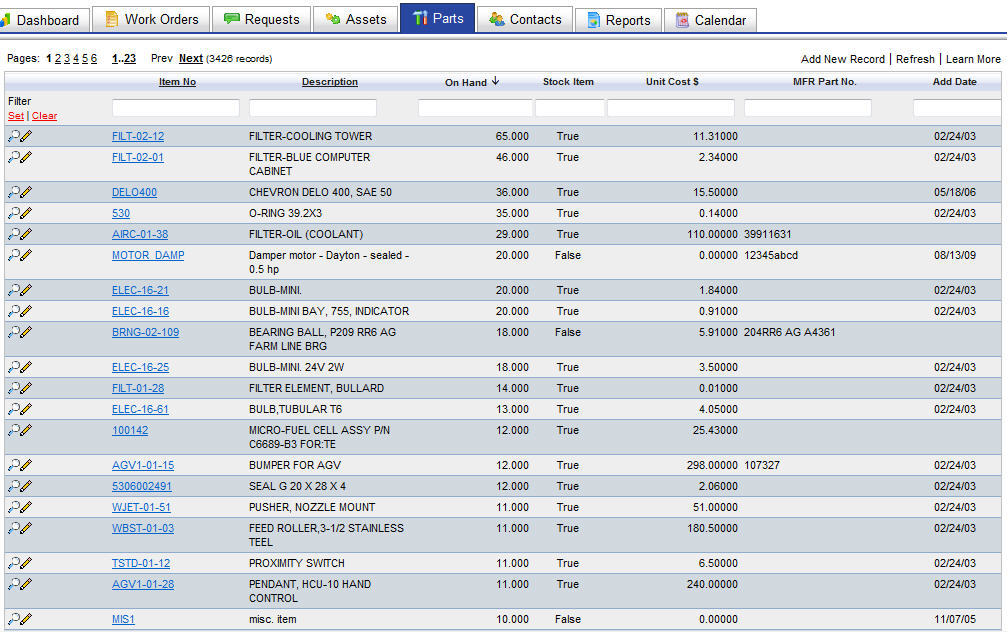
The parts are displayed in rows with column headers at the top of each row. Note that each part displayed in the list has its "Item No.‟ underlined. This means you can click the Item No. to see the part record in detail. To the left of each row are two icons. The magnifying glass icon will open the detail record of the part. The pencil icon will open the part record in edit mode.
From this screen you can add a new part record to the list by clicking AddNewRecord in the upper right corner. If any changes were made to a part while this window was open, click Refresh to reload the page. The LearnMore link provides a brief description of the list view and how to navigate around it. To close the window and return to the main menu, click the CloseWindow link in the upper right corner.
Click the FormOptions link at the bottom of the list to change the default settings of how this screen is displayed.
SearchingyourParts
You can expand your search further by applying sorts and/or filters.
Sortingthelist
Click on one of the column headings and the list will sort in ascending order. Once sorted, a small arrow icon (pointing up) will appear to the right of the column name. This indicates that the list is sorted in ascending order. Click the arrow icon and the list will sort again, this time in descending order.
ApplyingFilterstotheList
Filters are used to search the whole list and display the matching results. For example, if you wanted to see only the parts with a location that begins with the letter 'S', you would type the letter S in the filter for the Location column and then click the red Set link on to the left of the filter row. Besides displaying the results, the number of records that matched the filter expression will display in the upper left of the screen. You can apply single or multiple filters at one time if needed.
To remove the filters, click the red Clear link and click Set again. The full list will display.
TIP: The system remembers the filters and sorts that you apply and will display it the next time you navigate to that list.
DetailView
The det ail view is accessible from the List view by clicking on the Item No. or clicking on the magnifying glass icon in the left column of the list.
ail view is accessible from the List view by clicking on the Item No. or clicking on the magnifying glass icon in the left column of the list.
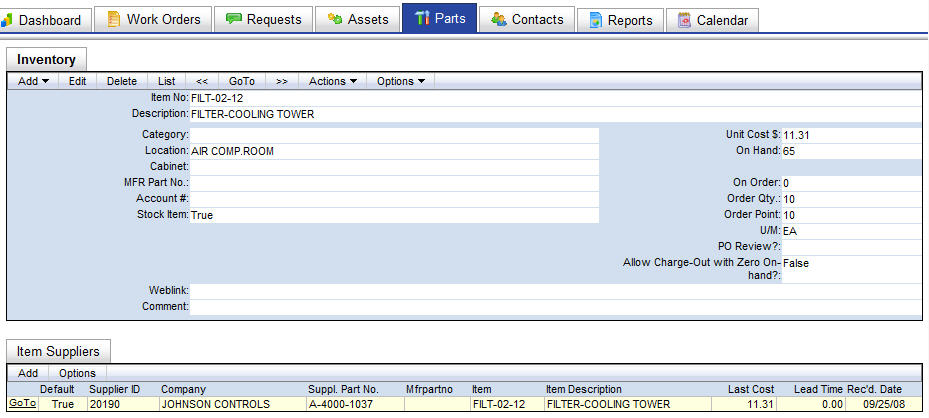
The detail view contains all of the information of a part from the Parts table. From this screen, you have total control of your parts inventory.
NOTE: WitheMaintX3, youhavetheabilitytoaddorremovefieldstothescreenaswellaschangefieldnamesandattributes, screenlayout, colors, etc. Yourscreenmaylookslightlydifferentthantheexampleabove.
Options at the top left corner of the screen include:
Add – Opens a blank record for entering a part.
Copy/Add – Opens a new record in Add mode and populates the form with the previous record's values.
Edit – Opens the record in Edit mode for changing the part's information.
Delete – Marks the record for deletion and removes it from the list view.
List – Returns to the list view. Previous – Displays the detail of the previous record (ordered by ID).
<< – Displays the detail of the previous record (ordered by ID).
>> – Displays the detail of the next record (ordered by ID).
GoTo – Opens a window that allows you to navigate directly to a record by entering the Item No.
Actions – Displays the different actions you can choose to perform.
Adjustments – Opens the form to change the existing on-hand quantity.
History – Displays the transaction history of the part directly below the display fields
KeyChange – Allows you to change the key field of the part.
Purchases – Opens a new form to indicate purchases made from the suppliers.
Recalculate – Open the Recalculate window to fix any discrepancies caused by purchase order editing and voiding.
Options – Options can include LearnMore, ChangeForm, CustomizeForm, and ManageRelatedTables.
AddingParts
You can add new parts from either the list or detail view. From the list view, the AddNewRecord link is directly above the field headers, on the right and will open a new window in add mode. From the detail view, the Add choice is the first in the main menu bar and will change the current window to add mode. The Copy/Add option also changes the current window to add mode, except it will populate the form with the previous record's values for fast record entry.
The key field for Inventory Parts is ItemNo. and must be entered before SaveNewRecord is pressed. However, you should enter as much information as you can to help identify the part in a list. Click SaveNewRecord to save the new part. CancelChanges will completely discard the new part information.
EditingParts
The form for editing part information can also be accessed from either the list or detail views. From the list, click the pencil icon to edit the part information. From the detail view, click the Edit link in the menu bar. Both links will open the edit form in the existing window.
The Edit form is similar to the Add form, except that the key field and On Hand values cannot be edited. The key field is the unique identifier for the part and can only be changed using the KeyChange option. To change the On Hand quantity, use the Adjustments menu option.
Click SaveChanges to save the changes or CancelChanges to discard them. The form will return to the detail view of the part.
EditingInPlace
If EditInPlace is enabled, you can make changes to most fields without the need for entering edit mode. Enter the record’s detail screen by clicking on the Magnifying Glass icon or the Item No. link on the list view. Place your mouse cursor over the field you wish to edit. If the field is able to be edited, the cursor will change to a  . Double-click your left mouse button and the field will open in edit mode. Make your changes then click the save
. Double-click your left mouse button and the field will open in edit mode. Make your changes then click the save  icon to save your changes or click the cancel icon
icon to save your changes or click the cancel icon  to return without saving.
to return without saving.
If a field cannot be edited with Edit In Place, the cursor will change to a no symbol  . If editable, these fields require you to enter Editmode to make any adjustments.
. If editable, these fields require you to enter Editmode to make any adjustments.
DeletingParts
Deleting records is a two step process. The first step is to mark the record for deletion by clicking theDelete link. This removes the record from the list view but still allows you to locate it by using the GoTo link (if you know the record ID) or using the Nextand Previous links to page through the records. At this point, you can still un-delete the record by clicking the Undelete link.

The second step of the deletion process is to completely remove the records from the system. Go to the Remove Deleted Records link located in the Administration menu. This list displays the various tables that can hold records marked for deletion. Click the magnifying glass icon to preview items that will be deleted. Click the trash can icon to remove all the records for that section.
NOTE:TheRemoveDeletedItemsoptionpermanentlyremovesrecords. Thereisnowaytobringthemback. Usethisfeatureatyourownrisk.
Adjustments
To provide an accurate history of your inventory, the system does not allow direct editing of the On-Hand field. Instead, the Adjustments link is used to track inventory changes.
ViewingPartHistory
On the part detail screen, click the History link to access the history of transactions for the part. This will display in the bottom portion of the screen
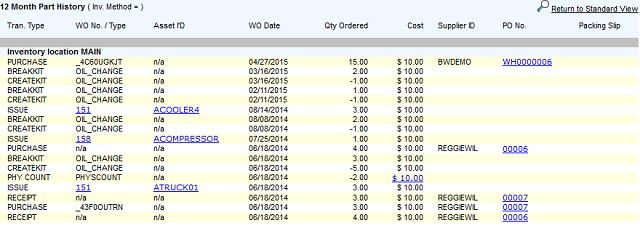
Click the magnifying glass to open the history in a separate window. This screen allows you to apply filters to specify both a time period and transaction type.
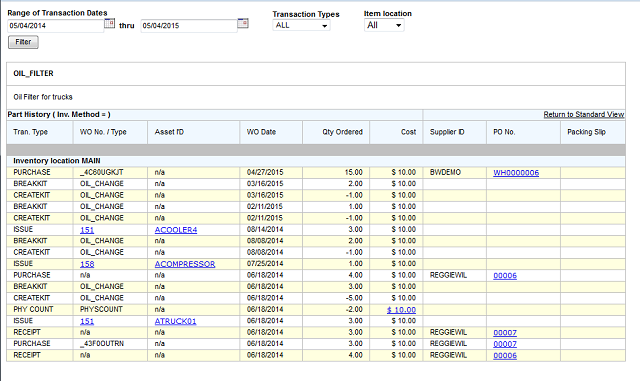
The links in these views navigate to other areas of the system that have affected this part. For example, clicking the PONo. link will take you to the purchase order on which this item appeared. Other areas include work orders and assets.
Click ReturntoStandardView on the right side of the history to go back to the original detail view for the part.
KeyChange
Because key fields are not able to be changed in edit mode, the KeyChange link has been provided to safely change the key field without corrupting the record.
Clicking KeyChange will open the key change form. Enter the new number in the field provided and click Process. This will display a summary of adjustments made to the table and verify the change is complete.
Click the Returntopartlink to return to the part without changing the key field.
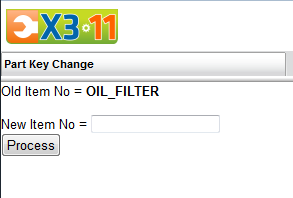
Purchase
The Purchaselink is one of three ways to order a part. Clicking the link displays the Re-Order form in a new screen.

Recalculate
The Recalculate feature is used to fix any discrepancies with either the OnOrder or OnHand amounts on the Parts’ details.